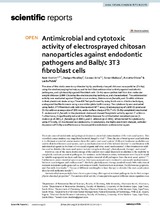Antimicrobial and cytotoxic activity of electrosprayed chitosan nanoparticles against endodontic pathogens and Balb/c 3T3 fibroblast cells
Date
2021-12Author
Ibrahim, A. O. I.
Moodley, Desigar S.
Uche, C.
Maboza, E.
Olivier, A.
Petrik, L.
Metadata
Show full item recordAbstract
The aims of this study were to synthesize highly positively charged chitosan nanoparticles (Ch-Np) using the electrospraying technique, and to test their antimicrobial activity against endodontic pathogens, and cytotoxicity against fibroblast cells. Ch-Np were synthesized from low molecular weight chitosan (LMW-Ch) using the electrospraying technique, and characterized. The antimicrobial activity was evaluated against Streptococcus mutans, Enterococcus faecalis, and Candida albicans in their planktonic state using a Time-Kill Test performed by using broth micro-dilution technique, and against biofilm biomass using a microtiter plate biofilm assay. The cytotoxicity was evaluated using Balb/c 3T3 fibroblast cells with the standard MTT assay. Electrospraying of LMW-Ch produced Ch-Np with an average size of 200 nm, and a surface charge of 51.7 mV. Ch-Np completely eradicated S. mutans and E. faecalis in the planktonic state and showed fungistatic activity against C. albicans. Furthermore, it significantly reduced the biofilm biomass for all the tested microbial species [S. mutans (p = 0.006), E. faecalis (p < 0.0001), and C. albicans (p = 0.004)]. When tested for cytotoxicity using 3T3 cells, Ch-Np showed no cytotoxicity. In conclusion, the highly positively charged, colloidal dispersion of Ch-Np are effective as a biocompatible endodontic antimicrobial agent. © 2021, The Author(s).

